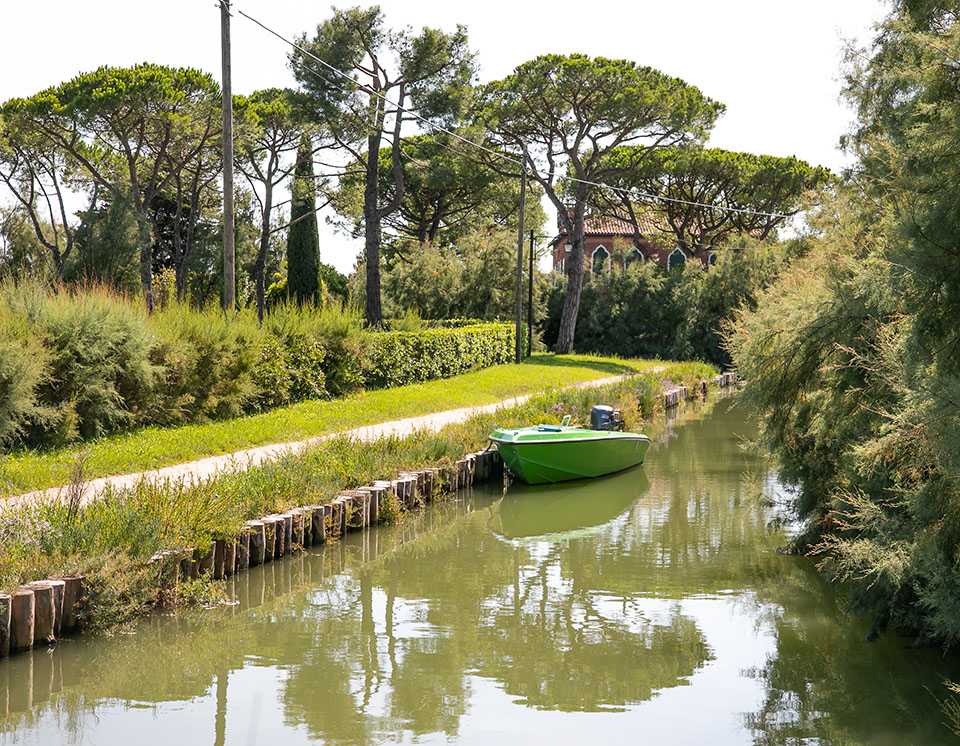Torcello
In Torcello, above our Venetian Taverna, we have three rooms overlooking the splendid park. It is a suggestive corner of greenery where you can taste the typical dishes of our tradition and breathe the smells of unspoiled nature. You can wander in the archaeological park, where students of all ages learn the dictates of the excavation every year, you can observe its artistic heritage and sit on the legendary throne of Attila. Then you can easily move to the nearby islands or to the historic center.
Burano and its colors
The island of Burano is located in the center of the Venetian lagoon, between the islands of Torcello and Murano. Its name comes from “Porta Boreana”, oriented to North-East, from where the Bora wind comes blowing. It stands out in the Venetian landscape because of its wonderful scenography of colorful houses, reflected in the crystal clear waters of the canals. Each house has its characteristic color gradation, a vital cunning from the past, used by fishermen to recognize their houses even in the thickest fog. Burano is represented also by its crooked bell tower, the typical pastry making, the traditional laces and the fishing boats. Staying in Burano means experiencing a reality that has remained unchanged through the centuries.
More
Archeo
During the barbarian invasions, the inhabitants of the coasts took refuge in the islands of the lagoon and decided to settle there, since they were protected by the safest “walls” that could exist: the waters of the lagoon. However, archaeological research suggests that the island of Torcello was already inhabited in Roman times and included in a territorial system that pivoted on the city of Altino, from which (starting from the II century BC) an organized road network branched off and a route for inland waters, through the lagoon, which allowed communication with Ravenna. In 639, the Basilica of Santa Maria Genitrice stood in Torcello; this construction confirms the shift towards the sea and the central importance of Torcello (around which numerous lagoon sites gravitated such as Burano, Mazzorbo, San Giacomo in Paludo and Murano) in the first phase of the formation of Venetian history. It was therefore in the northern lagoon, in Torcello in Lio Piccolo in San Lorenzo di Ammiana, San Francesco del Deserto that, before Rialto, came to create the new settlements and Torcello was undoubtedly the center of the economy of the area. The Museum and the Excavations are accessible from November to February 10.00 – 16.30 March-October 10.30 – 17.30 from Tuesday to Sunday from 10.30 to 17:30.
MoreA walk in the nature
The historical centre of Venice is immersed in the natural park of the lagoon like Torcello with its parks and its archaeological remains, but also the nearby island of Sant’Erasmo, called the Garden of Venice. It’s possible to cross Torcello “coast to caoast”, through an itinerary of about 2 km that winds through fields planted with vegetables, vineyards and orchards, interrupted by farms and old fish ponds. Other islands in the lagoon also have their natural parks, like Ca Roman reserve in Pellestrina.
MoreBoat Trip
For our guests we organize fascinating boat trips, to discover Venice and its islands through the framing of its origins, by water. Venitian bridges and palaces, the houses and the shores, they were created for that reason: to be admired from the perspective of a boat, from the lagoon. Alongside this unique vision of the city, we propose a life experience, a different excursion voted “to rediscover the social and environmental reality of the most suggestive places and the ancient traditions of the Venice Lagoon”. In collaboration with the San Marco Cooperative, founded in 1896 and made up of a hundred fishermen from the island of Burano, we plan boat excursions in which the fishermen themselves, around the islands of Burano and Torcello, talk about their professional activities, so that visitors can fully immerse themselves in the local fishing culture and tradition. The most used period for excursions is from April to October. You can choose between traditional fishing, that of the “moleche” on board of a “bragozzetto” or that with the lobster pots or nets, in a wooden boat.
More




